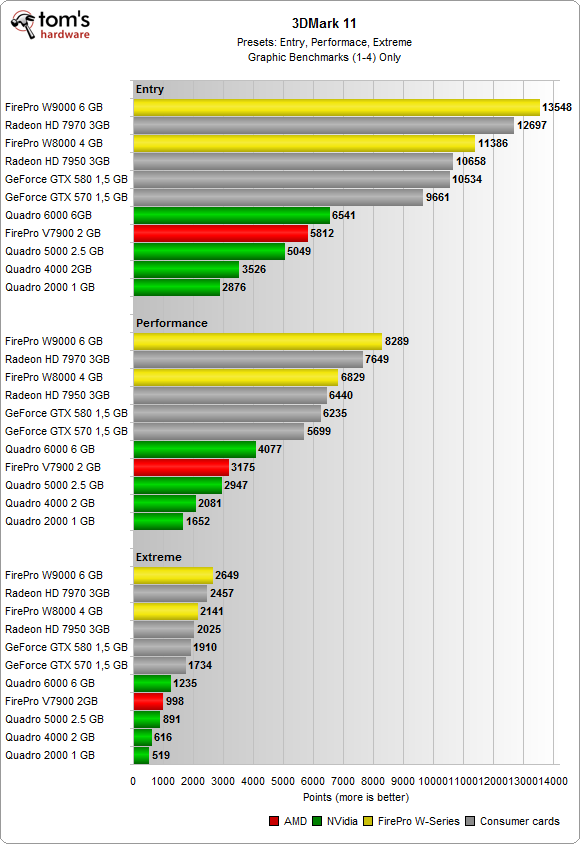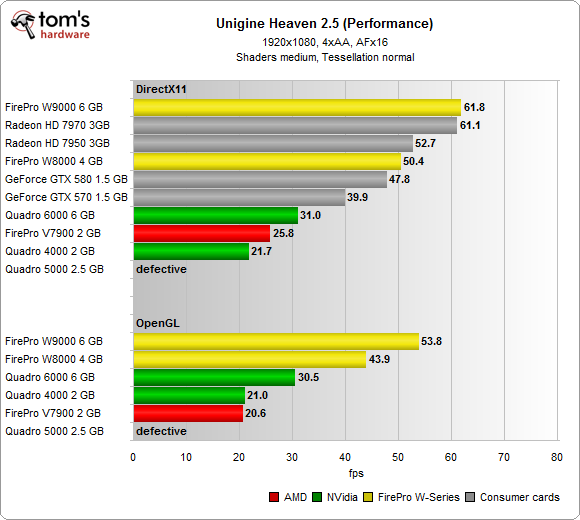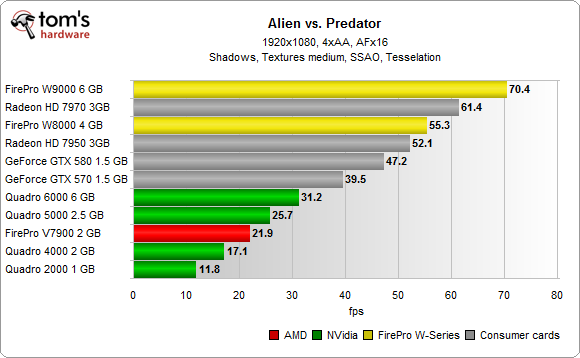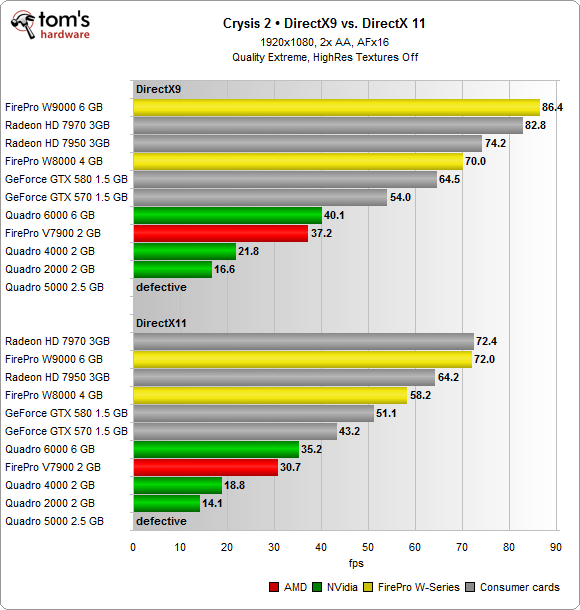AMD FirePro W8000 And W9000 Review: GCN Goes Pro
AMD’s GCN architecture, known for its strong compute and 3D performance, is finally being made available in the company's FirePro workstation graphics card family. Can AMD catch Nvidia? We test the two fastest FirePro cards to answer that question.
DirectX Benchmarks
DirectX Benchmarks
Our readers have asked us to compare expensive workstation graphics cards to much less expensive consumer graphics cards in DirectX-based and gaming-oriented applications. So, we tested the GCN and Fermi architectures (since the workstation-oriented Kepler-based cards aren't available yet).
The GCN-based workstation cards dominate 3DMark11. This isn’t altogether too surprising, since their clocks are a bit higher. AMD's and Nvidia's consumer cards do manage to beat the Quadro boards, which is likely a result of hardware and drivers.
AMD’s FirePro W-series cards dominate Unigine Heaven as well. Interestingly, the numbers generated under DirectX 11 and OpenGL fall very close together, with DirectX 11 yielding slightly higher overall frame rates and OpenGL producing slightly higher minimum frame rates.
During our Unigine benchmark, the Quadro 5000 exhibited what we first thought was a thermally-triggered shutdown. Even after we let it cool off, the card wouldn’t come on again, and the benchmark system’s PSU immediately shut down after starting the computer when it was installed. Consequently, the remaining benchmarks don't include the Quadro 5000, which isn’t too much of a problem, since we're almost done testing at this point anyway. It’s not a good sign that an expensive card like the Quadro 5000 shows this kind of major defect after only 10 hours of operation in an open case, though.
The Aliens vs. Predator benchmark looked similar to the previous ones, so we decided to give Crysis 2 a go. AMD’s FirePro W-series cards do well in this test. The consumer cards do manage to inch out the workstation boards in our second benchmark, but we like the FirePro W-series' output quality better. Using a $4000 card like this feels a little decadent, but it sure is fun!
Get Tom's Hardware's best news and in-depth reviews, straight to your inbox.
Current page: DirectX Benchmarks
Prev Page Basemark CL: Video Processing Next Page OpenCL Benchmarks
Igor Wallossek wrote a wide variety of hardware articles for Tom's Hardware, with a strong focus on technical analysis and in-depth reviews. His contributions have spanned a broad spectrum of PC components, including GPUs, CPUs, workstations, and PC builds. His insightful articles provide readers with detailed knowledge to make informed decisions in the ever-evolving tech landscape
-
mayankleoboy1 Typical of AMD : releasing cards without proper drivers.Reply
I bet most professionals wont touch these cards until atleast 3-4 driver revisions. These cards are newer, and perform worse than competitions older. -
mayankleoboy1 1.How does the CPU performance affect the benchmarks ? IOW, are these softwares enough offloaded on to the GPU, that changing the CPU to a much better Intel Xeons wont affect the performance much ?Reply
2. Also, how do the consumer cards perform on these pro softwares ?
-
rdc85 They are new architecture, it's kinda expected result. I can see there a room for improvement, but without the application that can take advantage of it, then it will useless..Reply
in the end I'm glad to see that AMD graphic section is trying to make an effort, not like the their proc section.. -
bystander mayankleoboy1Typical of AMD : releasing cards without proper drivers.I bet most professionals wont touch these cards until atleast 3-4 driver revisions. These cards are newer, and perform worse than competitions older.Did you not read all the benchmarks? In many of the benchmarks it beat out Nvidia's offering by a lot, some were even, some were worse. And they are cheaper than the those Nvidia cards it would seem by the price offering of 4.2k for the Quadro 6000 right on the last page, compared to 4k for the W9000 and 1.6k for the W8000.Reply
So depending on what you use it for, it may very well be a great choice. -
Please note that dozens of software companies (all the most prevalent in DCC and CAD) have thoroughly tested and certified the drivers for the W8000 and W9000 cards. This means that users of these applications should not be concerned about driver stability or user experience.Reply
Yes, this is a brand new architecture and yes, performance improvements will continue to be made with subsequent driver optimizations.
-
ohim Even though no one will prolly ever play games on a workstation, this are the first cards to have equal or superior gaming performance over the consumer cards also. Wonder if taking a HD 7970 and possibly mooding the bios for a FirePro one how will it impact the workstation benchmarks.Reply -
mayankleoboy1 ohimEven though no one will prolly ever play games on a workstation, this are the first cards to have equal or superior gaming performance over the consumer cards also. Wonder if taking a HD 7970 and possibly mooding the bios for a FirePro one how will it impact the workstation benchmarks.Reply
AFAIK, its not possible now to BIOS mod a regular 7970 into a W9000. AMD and Nvidia have become smarter.



